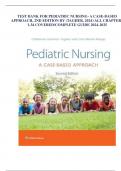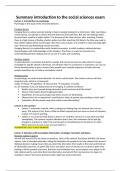TEST BANK FOR PEDIATRIC NURSING- A CASE-BASED
APPROACH, 2ND EDITION BY (TAGHER, 2024) ALL CHAPTER
1-34 COVERED/COMPLETE GUIDE 2024-2025
, Pediatric Nursing – A Case-Based Approach 2nd Edition Tagher Knapp Test Bank
Chapter 1: Bronchiolitis
1. Which intervention is appropriate for the infant hospitalized with bronchiolitis?
a. Position on the side with neck slightly flexed.
b. Administer antibiotics as ordered.
c. Restrict oral and parenteral fluids if tachypneic.
d. Give cool, humidified oxygen.
ACCURATE CHOICE:->> D
REASONING:->>>Cool, humidified oxygen is given to relieve dyspnea, hypoxemia, and insensible fluid los
from
tachypnea. The infant should be positioned with the head and chest elevated at a 30- to 40-degree
angle and the neck slightly extended to maintain an open airway and decrease pressure on the
diaphragm. The etiology of bronchiolitis is viral. Antibiotics are given only if there is a
secondary bacterial infection. Tachypnea increases insensible fluid loss. If the infant is
tachypneic, fluids are given parenterally to prevent dehydration.
2. An infant with bronchiolitis is hospitalized. The causative organism is respiratory syncytial
virus (RSV). The nursing attendant knows that a toddler infected with this virus requires
what type of isolation?
a. Reverse isolation
b. Airborne isolation
c. Contact Precautions
d. Standard Precautions
ACCURATE CHOICE:->> C
REASONING:->>>RSV is transmitted through droplets. In addition to Standard Precautions and hand washin
Contact Precautions are required. Nursing attendant s must use gloves and gowns when entering
the room. Care is taken not to touch their own eyes or mucous membranes with a contaminated
gloved hand. Kids are placed in a private room or in a room with other kids with RSV
infections. Reverse isolation focuses on keeping bacteria away from the infant. With RSV, other
kids need to be protected from exposure to the virus. The virus is not airborne.
3. A toddler has a chronic cough and diffuse wheezing during the expiratory phase of
respiration. This suggests what condition?
a. Asthma
b. Pneumonia
c. Bronchiolitis
d. Foreign body in trachea
ACCURATE CHOICE:->> A
REASONING:->>>Asthma may have these chronic signs and symptoms. Pneumonia appears with an acute
onset,
fever, and general malaise. Bronchiolitis is an acute condition caused by respiratory syncytial
virus. Foreign body in the trachea occurs with acute respiratory distress or failure and maybe
stridor.
,4. Which nursing diagnosis is most appropriate for an infant with acute bronchiolitis due to
respiratory syncytial virus (RSV)?
a. Activity Intolerance
b. Decreased Cardiac Output
c. Pain, Acute
d. Tissue Perfusion, Ineffective (peripheral)
ANS. A
Reasoning 1: Activity intolerance is a problem because of the imbalance between oxygen supply
and demand. Cardiac output is not compromised during an acute phase of bronchiolitis. Pain is
not usually associated with acute bronchiolitis. Tissue perfusion (peripheral) is not affected by
this respiratory-disease process.
Reasoning 2: Activity intolerance is a problem because of the imbalance between oxygen supply
and demand. Cardiac output is not compromised during an acute phase of bronchiolitis. Pain is
not usually associated with acute bronchiolitis. Tissue perfusion (peripheral) is not affected by
this respiratory-disease process.
Reasoning 3: Activity intolerance is a problem because of the imbalance between oxygen supply
and demand. Cardiac output is not compromised during an acute phase of bronchiolitis. Pain is
not usually associated with acute bronchiolitis. Tissue perfusion (peripheral) is not affected by
this respiratory-disease process.
Reasoning 4: Activity intolerance is a problem because of the imbalance between oxygen supply
and demand. Cardiac output is not compromised during an acute phase of bronchiolitis. Pain is
not usually associated with acute bronchiolitis. Tissue perfusion (peripheral) is not affected by
this respiratory-disease process.
Global Reasoning: Activity intolerance is a problem because of the imbalance between oxygen
supply and demand. Cardiac output is not compromised during an acute phase of bronchiolitis.
Pain is not usually associated with acute bronchiolitis. Tissue perfusion (peripheral) is not
affected by this respiratory-disease process.
Chapter 2: Asthma
1. The nursing attendant is caring for a toddler hospitalized for status asthmaticus. Which
assessment finding suggests that the toddler s condition is worsening?
Hypoventilation
a. Thirst
b. Bradycardia
c. Clubbing
ACCURATE
CHOICE:->> A
, REASONING:->>>The nursing attendant would assess the toddler for signs of hypoxia,
including restlessness, fatigue, irritability, and increased heart and respiratory rate. As the
toddler tires from the increased work of breathing hypoventilation occurs leading to increased
carbon dioxide levels. The nursing attendant would be alert for signs of hypoxia. Thirst would
reflect the toddler s hydration status. Bradycardia is not a sign of hypoxia; tachycardia is.
Clubbing develops over a period of months in response to hypoxia. The presence of clubbing
does not indicate the toddler s condition is worsening.
2. Which finding is expected when assessing a toddler hospitalized for asthma?
a. Inspiratory stridor
b. Harsh, barky cough
c. Wheezing
d. Rhinorrhea
ACCURATE
CHOICE:->> C
REASONING:->>>Wheezing is a classic manifestation of asthma. Inspiratory stridor is a clinical manifestati
of
croup. A harsh, barky cough is characteristic of croup. Rhinorrhea is not associated with asthma.
3. A toddler has had cold symptoms for more than 2 weeks, a headache, nasal congestion
with purulent nasal drainage, facial tenderness, and a cough that increases during sleep. The
nursing attendant recognizes these symptoms are characteristic of which respiratory
condition?
a. Allergic rhinitis
b. Bronchitis
c. Asthma
d. Sinusitis
ACCURATE
CHOICE:->> D
REASONING:->>>Sinusitis is characterized by signs and symptoms of a cold that do not improve after 14
days, a
low-grade fever, nasal congestion and purulent nasal discharge, headache, tenderness, a feeling
of fullness over the affected sinuses, halitosis, and a cough that increases when the toddler is
lying down. The classic symptoms of allergic rhinitis are watery rhinorrhea, itchy nose, eyes,
ears, and palate, and sneezing. Symptoms occur as long as the toddler is exposed to the
allergen. Bronchitis is characterized by a gradual onset of rhinitis and a cough that is initially
nonproductive but may change to a loose cough. The manifestations of asthma may vary, with
wheezing being a classic sign. The symptoms presented in the question do not suggest asthma.
4. What is a common trigger for asthma attacks in kids ?
a. Febrile episodes
b. Dehydration
c. Exercise
d. Seizures
ACCURATE





